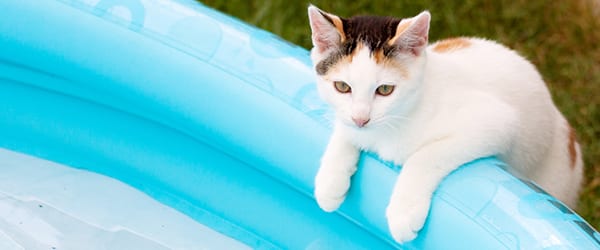Keeping Cool & Preventing Heastroke in Dogs & Cats in Edmond, OK
Cats and dogs have a harder time staying cool than we do. They release heat by panting, which is far less efficient than sweating! Plus, flat-faced breeds like Pugs, Bulldogs, Boxers, and Persians have it that much harder when expelling heat due to their shortened airways. As your pet’s guardian, it’s up to you to help them stay cool in the sticky hot summers of Edmond, OK! But don’t worry, we’re here to help with some pet heat safety tips so you can prevent cat and dog heatstroke.

- Remember, NEVER leave your pet in a parked car. Cars can heat up fast, even on a mild day, which can be extremely dangerous and even fatal to your furry friend. Don’t risk it! Leave them at home in the air conditioning!
- If the temperature reaches above 75 or 80 outside, it’s a good idea to limit your pet’s outdoor exposure, especially if the humidity is high as well.
- If your pet does have to be outside in the heat, keep them hydrated with cool, fresh water and make sure they have somewhere to lounge in the shade!
- Should you decide to grill up some burgers for dinner, keep your pet far away from the hot grill, both while it’s on and while it’s still cooling.
- When out on a walk, try not to walk on hot asphalt. The black tarmac radiates heat that not only can burn your pet’s paws but also cause their body temperature to rise rapidly.
- Speaking of walks, try to take your daily stroll earlier in the morning or later in the evening when temperatures aren't as high.
- While it might seem contradictory, resist the urge to shave your pet. The layers of your dog’s or cat’s coat actually help to hold cooler air closer to their body; and it protects them from sunburn, too.
- If you have an outdoor cat, make an effort to brush them more often in the summer to help dislodge any shedding hair and keep them cool.
Know the Signs of Heatstroke in Dogs & Cats
Heatstroke happens when your pet overheats to such a degree that their body begins to shut down. It’s a dangerous condition that, if left untreated, could be fatal. Knowing the early signs of heatstroke can be instrumental in preventing any lasting damage from this illness. Watch your pet for the following:
- Excessive panting
- Drooling more than normal or not at all
- Agitation, restlessness
- Lethargy and unresponsiveness
- Very red or very pale gums
- Vomiting and/or diarrhea
- Seizures
- Collapse

Panting, drooling, and changes in behavior are the early signs of overheating and can be addressed by taking your pet into a cooler area and giving them plenty of water and rest. It’s still a good idea to call your veterinarian though, even if they start to perk up, just so that they can give any further advice or recommend any further treatment. If your pet begins vomiting, having diarrhea, having seizures, or collapsing, it is of paramount importance that you bring them to an emergency vet as soon as possible. These symptoms mean heatstroke has progressed, and it could mean damage to your pet’s internal organs, or even death if not immediately treated.
If you ever have concerns about your pet’s health, whether you fear heatstroke or something else, don’t hesitate to call us at (405) 701-9000!
